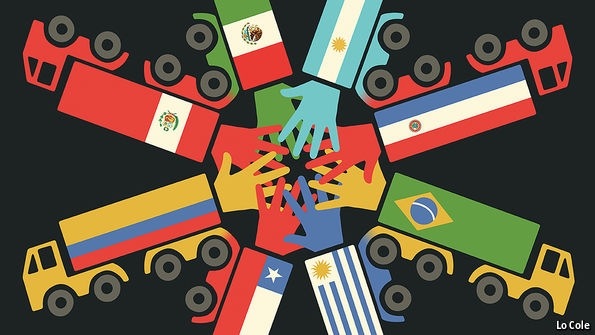There has never been a better time for Latin American integration


It is Saturday lunchtime, and about 30 trucks are parked at each of the customs posts on either side of the bridge across the broad Uruguay river that marks the border between Argentina and Uruguay. Both countries are members of Mercosur, a would-be customs union that also embraces Brazil and Paraguay. In theory, internal borders should not exist in Mercosur. In practice, customs, sanitary inspections and other paperwork mean that the trucks are delayed for up to 24 hours, says Oscar Terzaghi, the mayor of Fray Bentos, on the Uruguayan side.
This represents an improvement. For three years before 2010, access to the bridge—the shortest land route between the two capitals, Buenos Aires and Montevideo—was blocked by Argentine environmentalists with the support of the country’s president, Cristina Fernández. They claimed that a planned paper mill at Fray Bentos would pollute the river. The dispute ended only when the mill was operating and the International Court of Justice ruled that there was no evidence of pollution.
For the past half-century, Latin American politicians have talked incessantly about regional integration. But they have struggled to make it happen. Despite a big increase in trade agreements among Latin American countries this century, the share of their exports that stays within the region has remained stubbornly around 20%, according to a new report from the World Bank. That is low compared with Canada and the United States (35%), East Asia (50%) and 18 core members of the European single market (60%).
There are several reasons for this. Many Latin American economies are small, produce similar things and are separated by huge distances, all factors that tend to discourage trade. That is bad news: trade boosts economic growth, by increasing efficiency and by the “learning” that comes from exporting to other markets or importing more sophisticated goods. And after six straight years of economic weakness, Latin America is casting around for new sources of growth.
Some of the centre-right governments that have recently come to power in South America are keener on open trade than their left-wing predecessors, especially in Mercosur. Unfortunately, the biggest gains in efficiency and learning might come from more trade with the United States, something Donald Trump seems uninterested in. But there are other things the region can do to help itself.
There is much talk in South America of “convergence” between Mercosur and the Pacific Alliance, a free-trading group comprising Chile, Colombia, Mexico and Peru. Next month in Buenos Aires, foreign ministers from both will meet for the first time. Yet the groups have different rules and philosophies; merging them is a technical and political impossibility. One option would be to use ALADI, a 1980 integration treaty, to harmonise and improve existing preferential agreements, says Enrique Iglesias, a Latin American elder statesman.
The easiest gains lie in tackling bureaucratic obstacles to trade. Susana Malcorra, Argentina’s foreign minister, says that with her Mercosur counterparts she has identified 80 such obstacles, such as conflicting norms and standards, which they will try to do away with. They have pledged to unify border posts where there are two, as on the river Uruguay. Better transport links and open-skies agreements are essential, too. Transport costs in South America are unusually high.
The World Bank argues that regional and global integration go hand in hand. Mr Trump has killed the Trans-Pacific Partnership; the Pacific Alliance hopes to resurrect it without the United States, linking its members to Asia. Mercosur retains fairly high external tariffs and has few trade deals with others. It is making a fresh effort to conclude long-stalled talks with the EU; an agreement would provide a “road map and a corset” for liberalisation, says Ms Malcorra. But without Britain, the EU is even less likely to offer the market access Mercosur wants for its farm exports.
The rhetoric of integration masks often-shameless protectionism by business, especially in Argentina, Brazil and Colombia. This has bred cynicism. The problem, says Roberto Bouzas, a trade specialist at San Andrés university in Buenos Aires, is how to translate the abstract demand for integration IGNORE INTO a concrete political agenda backed by organised interests, and find leaders willing to carry this out.
There is a flicker of hope. For the first time, says Ms Malcorra, there is “a very determined attitude from all the presidents”. Unfortunately, the region’s governments are politically weak. But they know they must rekindle growth, and that regional integration will help.



